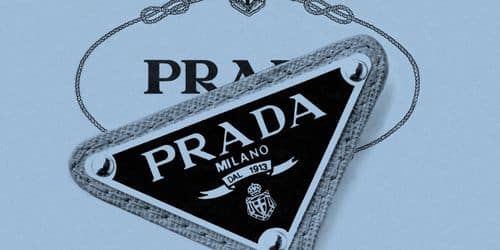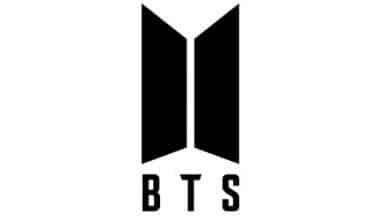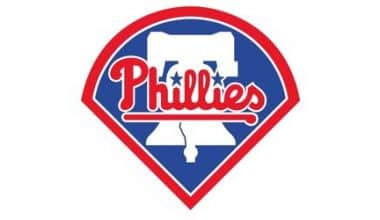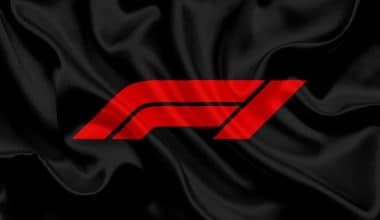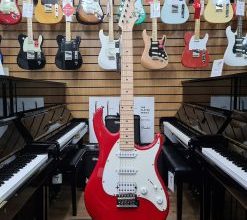Prada s.p.a. is a luxury fashion house based in Italy. The Prada logo shows that the company has a long history of making leather goods for the Italian royal family. Its newer, more streamlined design upholds the company’s reputation for simplicity, elegance, and quality. This article talks about the meaning of Prada logo loafers, clothing, shoes, and the devil wears.
Prada Logo Meaning
Prada introduces Prada Symbols, a series of pop-up shops devoted to the women’s SS21 collection. A white and gold checkered floor, transparent displays, and mannequins characterize the design, which is defined by a glass structure embellished with triangle shapes that refer to the renowned Prada brand.
Mario Prada founded Prada, an Italian luxury fashion brand, in Milan in 1913. It is known for its leather handbags, travel items, shoes, ready-to-wear clothing, and other fashion accessories. Luxottica licenses Prada’s trademark and branding for eyewear and L’Oréal for fragrances.
Founding
In 1913, Mario Prada and his brother Martino founded the company, Fratelli Prada, a leather goods shop in Milan, Italy. At first, the store sold items with animals on them, as well as steamer trunks and handbags from England.
Mario Prada did not believe that women should have a place in business, so he barred female family members from working for him. Mario’s son had no interest in the business, therefore it was Mario’s daughter Luisa who took over and ran Prada for nearly twenty years. Miuccia Prada, Luisa’s daughter, joined the company in 1970 and finally succeeded her mother in 1978.
Miuccia started manufacturing waterproof backpacks using Pocono, a nylon fabric. In 1977, she met Patrizio Bertelli, an Italian who had started his own leather products firm at the age of 24, and he quickly joined the company. He gave Miuccia business advice, which she took. It was his suggestion that we stop importing English goods and modify our luggage.
However, over time, the fashion house erased the design aspects that linked it to Italian royalty. The rope pattern, coat of arms, and banner shape all vanished, leaving only a simple wordmark.
Development
Miuccia inherited the company in 1978 when revenues had reached $450,000. Miuccia was able to express her creativity with Bertelli as her business manager. She would later infuse her ideas into the Prada house, which would transform it.
In 1979, she produced her first collection of backpacks and totes. Her grandfather’s steamer trunk coverings were made of military-spec black nylon. The lines were not an instant success due to a lack of publicity and exorbitant costs, but they would go on to become her first commercial smash.
In the same year, Prada opened stores in important shopping areas in Florence, Paris, Madrid, and New York City. This helped the company grow in both continental Europe and the United States. In 1984, a shoe line was also set up. Miuccia Prada made the “classic Prada handbag” in 1985, and it was a big hit right away. Even though it was strong and useful, its clean lines and quality craftsmanship gave it the air of luxury that has come to be associated with Prada.
History
In 1913, the Prada fashion house opened its doors in Milan. Like many Italian companies, Fratelli Prada was the founder’s surname. Even in the twenty-first century, the family continues to lead the company, mostly as lead designers. Prada employs around 2,850 people worldwide and has an annual revenue of $2.20 billion as of 2010.
The Prada emblem originated in 1919 when the firm became the royal family’s supplier. So, the company got permission to use parts of the heraldry of the House of Savoy in its logotype. Prada’s first logo was the House of Savoy’s coat of arms and rope. Furthermore, the Italian corporation put its own wordmark on the design. Because Prada could compete with labels like Gucci because they had royal backing. Using royal emblems may be a good business strategy.
Miuccia and Bertelli married in 1987. In 1988, Prada debuted its women’s ready-to-wear collection, which became noted for its lowered waistlines and tight belts. Prada’s reputation grew as the fashion industry recognized its clean lines, sumptuous fabrics, and simple hues.
The label’s insignia was not as prominent a design element as those found on bags from other well-known luxury brands such as Louis Vuitton. It attempted to promote its lack of prestigious appeal, including its clothing, by portraying itself as “anti-status” or “inverse snobbery.” This is how it’s split below:
The 1990s
Prada’s inventiveness propelled it to the top of the fashion world, and the brand became a premium status symbol in the 1990s.
In 1998, sales were L70 billion, or $31.7 million. After working for the firm in Asia, Patrizio di Marco took over the booming business in the United States. He got Prada bags as part of the features in department stores, making them popular with fashion editors. Prada’s ongoing success was due to its “working-class” concept, which “was becoming trendy in the high-tech, IPO-driven early 1990s,” according to Ginia Bellafante of The New York Times Magazine.
Furthermore, Miuccia and Bertelli, now husband and wife, guided the Prada label on a careful expansion, making products scarce. Miu Miu, the high fashion label named after Miuccia’s nickname, began in 1992. Miu Miu appealed to both younger consumers and celebrities. Prada won the Council of Fashion Designers of America (CFDA) award for accessories in 1993.
The first men’s ready-to-wear collections appeared in the mid-1990s. Sales had reached US$210 million by 1994, with clothing accounting for 20% of overall sales. Prada got another CFDA award as “designer of the year” in 1995. Prada’s 18,000-square-foot Manhattan, New York, boutique debuted in 1996, making it the largest in the chain at the time. The House of Prada now has 40 stores worldwide, with 20 of them in Japan.
In 1996
The company had eight locations and outsourced work to 84 other Italian manufacturers. Prada and Bertelli set out together in 1996 to form Prapar B.V. The name was changed to Prada B.V., and Patrizio Bertelli was also the present CEO.
1996 was also a watershed moment in Prada’s aesthetics, propelling the brand’s global fame. Journalists praised Miuccia’s “ugly chic” style, which at first shocked customers with outfits that didn’t look very sexy but later proved to be strong and creative interpretations of how fashion and desire work together. Prada is a brilliant and imaginative designer.
1997
In 1997, Prada earned $674 million in revenue. Another store opened the next year in Milan. Bertelli, according to The Wall Street Journal, shattered the store’s windows a day before it opened after becoming displeased with the setup. Bertelli also bought stock in the Gucci group and later accused the company of “copying his wife’s designs.” In June 1998, Bertelli had a 9.5% return on investment of $260 million. Analysts suspected he was seeking to take over the Gucci group.
Bertelli, on the other hand, sold his interests to Mot-Hennessy • Louis Vuitton chairman Bernard Arnault for a profit of US$140 million in January 1998. In truth, Arnault was attempting to take over Gucci. LVMH has been purchasing fashion companies for some time and already owned Dior, Givenchy, and other high-end names. Gucci, on the other hand, avoided him by selling a 45% ownership to businessman François Pinault for $3 billion. The first Prada men’s clothes store opened in Los Angeles in 1998.
In 1999
Prada set out to build a portfolio of luxury brands like Gucci and LVMH. Prada paid $40 million to purchase 51% of Helmut Lang’s New York-based company in March 1999. Lang’s company was worth $100m. Months later, Prada paid US$105 million for full ownership of Jil Sander A.G., a German-based company with $100 million in annual revenue. As a result of the purchase, Prada gained a foothold in Germany as a result, and Jil Sander quit as chairperson of her namesake firm months later. However, Prada recently paid $170 million for 83% of Church & Company, an English shoemaker.
Prada and the De Rigo firm launched a joint venture to produce Prada eyewear that year. However, Prada and LVMH outbid Gucci in October 1999 to purchase a 51% share in the Rome-based Fendi S.p.A. Prada’s share (25.5%) was worth US$241.5 million out of the total US$520 million payable by Prada and LVMH. Prada assumed Fendi’s debts because the latter was in financial trouble.
Prada rose to the top of Europe’s luxury goods industry as a result of these acquisitions. From 1996 to L2 trillion, revenue tripled. The corporation was still in debt despite its apparent prosperity.
The 2000s
In the 2000s, the company’s merger and acquisition sprees slowed. However, the corporation has reached an agreement with Azzedine Alaia. In 2000, the US, Japan, and Europe set out unit dosages for skin care. A 30-day bottle of cleansing lotion costs $100. In June 2001, the company sought to offer 30% of its stock on the Milan Stock Exchange to help pay off debts totaling over US$850 million. But the offering slowed because people in the US and Japan were buying fewer luxury items. Under pressure from his bankers, Bertelli sold all of Prada’s 25.5% ownership in Fendi to LVMH in 2001. The sale only raised $295 million USD.
By 2006, Helmut Lang, Amy Fairclough, Ghee, and Jil Sander brands had all been sold. Carrefour chairman Luc Vandevelde runs the private equity group Change Capital Partners, which bought Jil Sander. Link Theory owns Helmut Lang now. Prada is still making payments on its Fendi debt. Equinox recently purchased 45% of the Church & Company brand.
In 2009
The Prada Spring/Summer 2009 Ready-to-Wear fashion show, held on September 23, 2008, in Milan, received infamous publicity because all of the models on the catwalk were stumbling—several stumbled, and two models fell down in front of the photographers and had to be assisted up by onlookers. They took off their shoes to resume their trek. Another model (Sigrid Agren) had to stop and return during the final walk because she couldn’t walk in her high heels any longer. When interviewed immediately following the presentation, one model stated, “My hands were trembling as I was having a panic attack.
The heels were really high. ” Miuccia Prada, on the other hand, blamed the silky tiny socks within the shoes, which were slick and moved inside the shoes, preventing the models’ feet from having a proper grip on the sole. Miuccia Prada also promised that the shoes offered in stores would have a lower heel and that the small socks would be sewn into the shoes to avoid further slips. However, many fashionistas correctly predicted that once the socks were stitched into the shoes, they would be non-washable and would quickly stink and turn grey. As a result, the shoes were never commercially available.
The 2010s
According to Fortune, Bertelli wanted to increase the company’s revenue to $5 billion by 2010.
Prada is the top importer of Turkish leather company DESA, which the Turkish Supreme Court held liable for unjustly terminating union members. The Clean Clothes Campaign, a European workers’ rights organization, was asking Prada to provide freedom of association at the factory. The Clean Clothes Campaign said on January 30, 2013, “Trade Union Harassment Continues at Prada Supplier.”
On May 6, 2011, the Hong Kong Stock Exchange was accused of authorizing Prada’s initial public offering (IPO) during the Prada Gender Discrimination Case, which Prada eventually won. Protests were held in front of the Hong Kong Stock Exchange by feminist NGOs and Hong Kong Legislative Council politician Lee Cheuk-yan.
The brand was among the list on the Hong Kong Stock Exchange on June 24, 2011, to raise $2.14 billion. However, it failed to meet expectations, as reported by AAP on June 17, 2011, and Bloomberg. Prada’s revenue in 2015 was 3,551.7 million euros, up 1% from 2014, while its gross operating profit plummeted 16.5 percent to 954.2 million euros.
In February 2015, The New York Times published an article by Charles Curkin regarding the use of ostrich leather by luxury fashion manufacturers and the horrific procedures used to extract it from the flightless birds. It was based on PETA’s months-long study and named Prada as one of fashion’s leading brands trading in ostrich skin products.
Prada clothes became available for purchase online for the first time in July 2016 through Net-a-Porter and Mytheresa. Prada’s sales went positive in March 2018 after decreasing since 2014, and the company’s stock rose 14% on the announcement.
The 2020s
Prada announced in 2019 that fur would be removed from the collection and all house brands by 2020, stating that “focusing on novel materials will allow the company to explore new boundaries of creative design while addressing the demand for ethical products.”
Miuccia Prada and Patrizio Bertelli appointed Belgian designer Raf Simons as co-creative director in February 2020. The fashion business stated in August 2020 that it will no longer utilize kangaroo leather in its products. Vanity Teen, a fashion magazine, supported the Prada Resort 21 campaign in 2020.
The Prada Logo Shape
Without a doubt, the Prada logo is one of the most recognizable and unique in the fashion industry. It is referred to as a “hybrid.” The logotype’s simple and consistent letter shapes sound like Prada’s brand name.
Each character is dynamic since they’re similar. This makes Prada one of the most well-known fashion companies in the world and helps it serve a functionalist purpose. The Prada logo is a sign of quality and authenticity that helps people remember the brand and the product.
The font, which has a blend of thin and thick strokes, is undoubtedly the wordmark’s most distinguishing element. The letter “R” has a characteristic line that makes it easily identifiable. Furthermore, the letter “A” has a distinct shape at the top.
Depending on the collection, the fashion house may change the logo. Some bags, for example, have Prada trademark plates with a triangle, some just say “Prada,” and still others say “Prada Milano.” A squiggle may also appear underneath.
The Prada Logo Colors
The Prada logo’s use of black represents integrity, purity, nature, elegance, and strength. The color scheme highlights the concept of minimalism and elegance. However, the classic Prada logo has always employed only one color, black, against a white background, regardless of its shape. Designers may use white or gold in particular visual contexts, but this is a slight exception to the overall norm.
The Prada Logo Font
Prada’s logo has hand-drawn typography. The original logo from 1919 is still used as the typeface for the current wordmark.
What Is the Concept Behind the Emblem?
The basic concept behind the design is a glaring lack of a logo. Prada, unlike other fashion businesses, declares “anti-status” or “reverse snobbery.” As a result, the wordmark is often found exclusively on small tags, buckles, and clasps.
What Is Prada’s Slogan?
A slogan is a catchy phrase or motto that is used in a clan, political, business, religious, or other setting to represent an idea or goal over and over again in order to persuade the general public or a smaller group of people.
“Be seen, be heard,” as the Prada slogan goes. Her drive is seen as a way for her to stake a claim on the world. Fashion is her preferred weapon, and she understands how to make people look twice. Prada has a knack for turning well-known classics or cliches of good taste into something new.
Does Prada Have a Logo?
Since 1919, the Prada logo has stayed the same, with very minor modifications depending on the product. Prada seamlessly transitioned from providing solely luxury baggage to selling high-fashion handbags, clothing, shoes, and accessories—you name it!
What Makes Prada So Special?
Prada has been designing and selling wonderfully produced and inventive handbags, clothing, shoes, and accessories for women, men, and even children for over 100 years. However, Prada is now synonymous with premium goods and never fails to disappoint.
Prada Logo Loafers
The Prada logo loafers are made of brushed leather, a signature material for the brand, and feature the triangular emblem, stitched borders, and a unique design on the rubber sole. The iconic macho loafer has been revamped with new volumes and refined features.
Unlike the usual Weejun pair (a Norwegian slang word for a classic leather slip with a leather strip on top, top stitching, and a low heel), Prada’s loafers have a boxy, thick sole and a distinct leather finish. On top, they each have the brand’s signature triangular emblem. These incarnations feature a stylish androgynous silhouette that can be dressed up or down.
The style was presented as part of the Italian label’s Pre-Fall 2020 collection, and given the tremendous demand globally, it is expected to become a fixture.
What Are the Many Prada Loafer Styles?
The Prada logo loafers’ soles set them apart from the slip-ons of other labels such as Chanel, Gucci, and Tod’s. Prada’s are large in size and shape, with unique grooves. Prada logo loafers are divided into three categories: classic, Chocolate line, and Monolith.
#1. Prada Logo Loafers in Classic Leather
The classic series has sleeker, more feminine shapes. The heel is streamlined (it can be flat or elevated), and the toe cap is rounded and formed similar to a pointe shoe. If you think these are too boring, don’t worry since there are a variety of types available, including patent leather and one studded with crystals if you want something with a little more bling.
#2. Prada Logo Loafers in Chocolate
Chocolate is simply the name of the loafer line, not the name of everyone’s favorite Valentine’s Day gift or color. This version has extra height and “chonk,” giving the shoes a boxier appearance. It’s also reasonable to say that the Chocolate is the most popular of Prada’s loafers, having been worn by celebrities like Hailey Bieber and Bella Hadid, to name a few.
#3. Logo Loafers in Prada Monolith Pointy Brushed Leather
The cult classic is available in two basic colors: all-black and all-white. This monochrome appearance is also one of the style’s distinguishing features. The women’s version has a pointed toe and a sleek upper silhouette that contrasts with the bulky sole.
The Devil Wears Prada
Lauren Weisberger’s time as an assistant to legendary Vogue editor Anna Wintour inspired the novel The Devil Wears Prada. Though the Vogue team was uncooperative, the production designer did get a glimpse of Wintour’s office, which inspired Priestly’s. Miranda Priestly, the demanding editor-in-chief of a high fashion magazine, hires a smart but sensible new graduate as an assistant.
This Devil Wears Prada is, however, a witty expose of New York’s fashion scene, with Meryl Streep in top form and Anne Hathaway holding her own. Anne Hathaway plays Andy, a recent college graduate with lofty ambitions. She is also hired to work as Miranda Priestly’s (Meryl Streep) assistant at the prestigious Runway magazine. Andy doubts her ability to survive Miranda’s grueling tour without being scorched.
- G-13 rating (Some Sensuality).
- Comedy, drama.
- English was the original language.
- David Frankel directs.
- Wendy Finerman was the producer.
- Aline Brosh McKenna and Don Roos are the writers. Lauren Weisberger’s (novel).
- Theatrical release date: June 30, 2006.
- Dec 12, 2006 (Streaming).
- Box Office (US Gross): $124.7 million.
- 1 hour 49 minutes.
- 20th Century Fox distributes.
- Dolby SRD, DTS, and SDDS sound mixes.
- Scope Aspect Ratio (2.35:1).
Also, the Devil Wears Prada message is ostensibly simple: Don’t sacrifice your life, well-being, and selfhood for a job. Behind that message is the same old refrain: Those who can’t handle it will fall by the wayside, and we’ll pretend they’re justified rather than weak.
Prada Clothing
The Prada clothing has the latest pieces from all your favorite brands, including Off-Arrows White’s motif T-shirts and sweaters and distressed AMIRI jeans to match. Keep it conscious with recycled Greg Lauren jackets. However, Prada clothing perfectly balances timeless classics with a whimsical design. Also with logo-plaque dresses, signature nylon puffer jackets, and a range of tops from simple logo-pouch T-shirts and intarsia knits to embellished evening styles, the label promotes uniform-like dressing.
Prada clothing first opened its doors in Milan nearly a century ago. Since the 1970s, the revolutionary Miuccia Prada has been in charge of the house. Since then, co-Creative Director Raf Simons has brought in a new era. Re-Nylon messenger bags and backpacks go well with America’s Cup sneakers and Monolith boots, which reinterpret a number of technical styles from the past. The triangle Prada logo plaque is on signature puffer jackets, and matching Symbole and Linea Rossa sunglasses also have the triangle logo.
Prada Shoes
Every day, Montevarchi manufactures approximately 700 pairs of shoes. Everything starts with prototyping. The creative office’s samples are analyzed and translated into technical drawings. They boast an exceptionally soft and comfortable upper, as well as a delightfully cozy midsole.
The Group’s goods are produced in 21 company-owned facilities, 18 of which are in Italy, one in the United Kingdom, one in France, and one in Romania, as well as by a network of long-standing and highly skilled contractors.
Prada debuted its first women’s footwear collection in 1979 and its first men’s footwear collection in 1993. Prada acquired Car Shoe, an Italian business known for its unique driving Moccasins, which are frequently seen by celebrities, in 2001.
Prada’s sneaker pedigree is undeniable, spanning nearly 25 years. Themes of technical performance materials and a design language that pays homage to original America’s Cup sneakers without becoming stale repeat throughout Prada’s sneaker history.
How Old Is Prada Brand?
Mr. Mario Prada (Miuccia Prada’s grandpa) opened the first Prada store in 1913. Mr. Prada’s first store opened in Milan’s Galleria Vittorio Emanuele II (the world’s oldest operational shopping mall, and a pretty darn nice one at that), selling bags, trunks, and travel accessories to affluent Milanese fashionistas. It is approximately 109 years old.
Is Prada a Designer Brand?
Miuccia Prada (born May 10, 1949, in Milan, Italy) is an Italian fashion designer best known as the head designer of the Prada fashion house. She is well-known for her use of simple designs to achieve a traditional look with a modern twist.
How Can You Tell if Prada Is Real?
The brand mark on newer releases should always be two lines: PRADA on the first and MADE IN ITALY on the second. The bag is false if the brand stamp has less than two or more three lines of information.
Made in Italy, on the other hand, is sometimes placed on a separate tag in the bag’s internal pocket. A trademark stamp with the house’s identifying information may be found inside every genuine Prada bag. It’s always on the back wall of the bag, either at the top seam or just under the entrance of the internal pocket.
Is Prada Still Luxury?
Prada has been designing and selling wonderfully produced and inventive handbags, garments, shoes, and accessories for women, men, and even children for over 100 years. Prada is now synonymous with premium goods and never fails to disappoint year after year.
Prada’s clothing is refined, simple, and downright classy. Their designs exude serene elegance and wealth. It would sometimes take a designer product expert to identify Prada products. That’s because they’re not loud or flamboyant on the street. Luxury fashion labels market elite, sought-after, and pricey apparel, shoes, and accessories.
Who Is Prada Owned By?
Miuccia Prada is the co-CEO and chief designer of the Prada handbag and fashion empire, which her grandfather began in 1913. She co-runs the company with her husband and co-CEO, millionaire Patrizio Bertelli. She and her siblings Alberto and Marina inherited the company in 1977.
The Group owns some of the world’s most iconic luxury brands, including Prada, Miu Miu, Church’s, Car Shoe, the ancient Pasticceria Marchesi, and Luna Rossa, and works tirelessly to increase their value through increased exposure and appeal.
What Country Is Prada From?
Miu Miu, Church’s, Cas Shoe, and Pasticceria Marchesi are among its brands. Mario Prada created the company in 1913, and it is headquartered in Milan, Italy.
What Is the Top 10 Luxury Brand?
The following are below:
- Hermes.
- Gucci.
- Ferrari.
- Rolex.
- Guerlain.
- Dior.
- Chanel.
- Porsche.
- Vuitton, Louis Vuitton.
- Cartier.
What Is the Highest Luxury Brand?
With global revenue of $31.6 billion, Porsche is the most expensive luxury brand. However, it was founded in 1931 and is headquartered in Stuttgart, Baden-Württemberg, Germany. It is also owned by Volkswagen AG and produces luxury automobiles.
Conclusion
As time went on, Prada built a second store in the Galleria Vittorio Emanuele, the heart of Milan’s shopping district, on the site of Felice Bellini’s historic “London House” shop from the 1960s. This store opened in 1983. However, as they grew, they ventured into other products like clothing, shoes, etc. They are obviously among the best brands.
Related Articles
- Jumia Flash Sales 2020: Top 10 discounts to look out for
- Handbag Brands: the Best 15 Brands in 2023(Updated!)
- BAG BRANDS: 2023 Top 25+ Luxurious and Designers Bag Brands
- Luxury Bag Brands: Top 2023 Luxury Handbag Brands List (Updated)
- Expensive Purse Brands: List Of Most Expensive Purse Brands
- https://businessyield.com/brand-stories/spitfire-logo/
